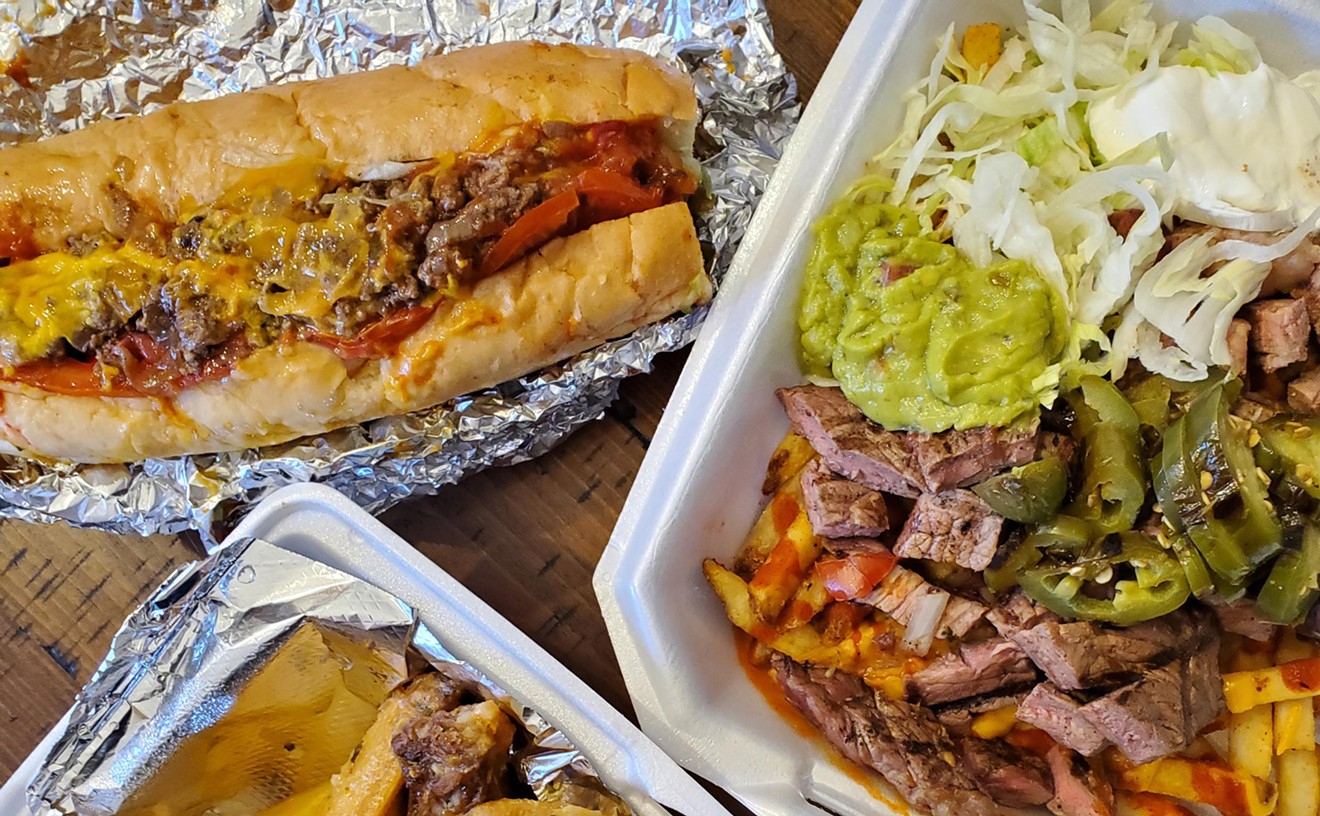After a hurricane devastated El Salvador last fall, Rincón's owners were worried they wouldn't be able to stay open because so many local Salvadorans were sending their money home instead of frequenting the restaurant. Over six months later, though, the eatery is still here and still cooking up great chiles rellenos--football-sized and stuffed with chopped pork and chicken--along with intensely flavored soups (the sopa de mariscos is packed with seafood) and beautiful French-style sauces.
But if you're hankering for some pupusas--and believe me, once you've had a few, they'll make their way into your subconscious--with a little bit of practice, you can turn your kitchen into a pupuseria. The following recipe is a combination of two that I found recently, one in Saveur magazine's January 1999 issue, which contained a review of a Louisiana pupuseria (does that mean Denver's actually on the cutting edge of a trend?), and the other from an out-of-print cookbook called The World's Food, which has no author but was compiled from several international newspaper sources dating back to the Sixties. The Saveur version contained only pork and kept coming out greasy, while The World's pupusas were overly complicated. The recipe that follows, I think, represents a happy medium.
The Saveur article also included some helpful hints on shaping the pupusas, including the advice that you not stuff them like pitas but instead shape the dough into a bowl in the palm of your hand, place the fillings inside the bowl, and then slowly work the dough around into a ball before you flatten it. Although that technique worked every time, you really can't rush it. And while grilling the pupusas works best, unless you have a commercial-grade grill, you'll spend a lot of time picking chunks of masa harina out of the charcoal. So I recommend pan-frying or, even better, throwing them on a hot griddle.
Good melting cheese is crucial, too, so try to track down some queso asadero, which you can usually get at The Cheese Company (735 South Colorado Boulevard, 1024 South Gaylord Street) or at a Mexican market. Saveur says to substitute mozzarella in a pinch, but I've found that provolone is closer to asadero's texture.
Pupusas
3 1/2 cups masa harina (corn flour)
2 1/4 cups plus 4-8 tablespoons hot water
1 pound ground pork, ground beef or ground turkey, or a combination of the three
1/2 large onion, finely diced
1 clove garlic, minced
1 medium jalapeno, seeded and minced
1 cup grated queso asadero (you can also use mozzarella, provolone or Monterey Jack)
Mix masa harina and water together in a large bowl. Cover with a damp towel and set aside for 30 minutes. Meanwhile, in a large, non-stick skillet over medium-high heat, saute ground meat and onion until meat starts to brown and most of the fat has been rendered. (Note: If using turkey, the meat may start to stick, so add a little water.) Lower heat and add garlic and jalapeno, cooking until garlic softens (do not let it brown). Pour fat off into a bowl and set aside; drain meat mixture and chop fine. Then, a tablespoon at a time, add water to the masa harina mixture until it is as soft as possible without being wet or sticky. Cover with plastic wrap.
To make the pupusas, make a ball of dough 2 to 3 inches in diameter. Dip your fingers into the reserved fat and moisten the palm of your hand; place the ball on it and press down in the center of the ball to make a small bowl. Gently flatten it all the way around, retaining the bowl shape, until it's about a half-inch thick. Fill the center with 2 to 3 tablespoons of meat, cheese, or a combination of both. Cupping the bowl in one hand, dip your other fingers into the fat and use it to smooth the dough up and around the filling until it closes, taking care to keep the dough from tearing. Pinch to seal, then gently flatten the whole thing into a fat disk.
When all the pupusas have been made, rub them with the remaining fat and fry in a skillet or on a griddle over medium-high heat until they're browned on both sides, about 3 minutes per side. Serves 8.
For the health of it: The Denver Post's April 18 investigation of the City of Denver's health-department inspections left a bad taste in lots of mouths--and not just at the 22 eateries that ranked as the worst offenders. I know I won't be going to Las Palmeras II, at 4745 Federal Boulevard, anytime soon--with seventy violations, it rated as the baddest of the bad, and readers could be forgiven for wondering why the city hadn't shut it down. (Or why Howard Johnson's, the hotel it shares space with, continues to put up with it.) My editor had fond memories of the restaurant's green chile dating back to the Eighties, but when she returned to Las Palmeras two years ago, the smell of body odor was so pervasive that even she and an iron-stomached friend were put off their feed.
Still, a few restaurants that have completely clean bills of health and weren't even mentioned in the article say they've been adversely affected by it: BD's Mongolian Barbecue (1620 Wazee) and Paul's Place (3000 East First Avenue and 1600 California Street). That's because their names sound much like those of two sinners on the Post list--Mongolian Barbecue, at 837 16th Street, in the food court; and Paul's Cafe and Steakhouse, at 2601 West Alameda Avenue--and some readers can't tell the difference.
"BD's has had no critical violations, and their health-inspection report has been blown up and posted at the restaurant," says restaurant consultant John Imbergamo, who handles the Michigan-based chain's local PR. "They've gotten innumerable phone calls from people asking about the article, and quite a few diners have made it clear that they thought it was BD's listed."
A few days after the article came out, Imbergamo says, two TV sales reps "were sitting in my office telling me that they used to go to BD's, but since the article, they won't go back." And then a marketing person from Neiman Marcus told him that she wouldn't eat at Paul's Place in the Cherry Creek Shopping Center because of its bad record. "When I argued with these people that it wasn't BD's or Paul's Place, they were pretty insistent that they'd read it with their own eyes," Imbergamo says.
Over at Paul's Place in Cherry Creek, an employee says he's been asked several times about the Post article by diners, including two who wanted to see the health-inspection report.
While the Post project also included a profile of a health inspector and a discussion of food poisoning, it was the list of chronic culprits that concerns many restaurateurs. "I think when the worst [restaurant] had seventy violations and the next worst had 26, you're talking about a real drop-off and a real difference in the possibility of illness spreading," Imbergamo says. "And they didn't differentiate between mouse shit in the flour and a missing thermometer in the cooler."
I agree that a distinction needs to be made about which violations are dangerous. But having worked in restaurants and eaten in more than my fair share of them, there's nothing that scares me more than food poisoning. In the past eight years of reviewing restaurants in two states (I worked in Florida before moving to Colorado five years ago), I've had a dozen cases of food poisoning documented by a physician--meaning that I was forced to seek medical attention, because of either dehydration or severe symptoms--including e. coli (which came from my children's daycare), salmonellosis, perfingens and staphylococcal poisoning. And then there were many more times when the symptoms were milder but still awful. Staphylococcal poisoning is the one I've suffered the most, and it comes from restaurant employees not washing their hands after they use the bathroom.
My doctor told me that when people say they have the stomach flu, it's more likely that they have food poisoning. Once you get a bout, it can screw up your system for days--and in the case of e. coli, for weeks or months. The bacteria stay in your intestinal tract, which means that taking antibiotics for another illness can kill out the good bacteria that keep the bad stuff at bay, and you get to experience food poisoning all over again.
When I worked in restaurants, we had little tricks for foiling the inspectors, like keeping our hats in the drawers under the prep table to throw on at a moment's notice and having someone be the designated cooler person who would race to make sure everything was up to snuff while the rest of us stalled the inspector. We also tasted sauces with our pinkies--double-dipping many times--and, during rush periods, I saw more than one prep person use the same cutting board for boning chicken and chopping vegetables that weren't going to be cooked. Good help is hard to find.
"The thing that scared me about the Post's article is that there are two ways for a restaurant to look at its relationship with the health department," Imbergamo says. "It can be that when they come in, you run around like hell and fix stuff, or you can look at it as, these are the people who are helping you do a better job. And I think that restaurants are going to look at it as the former if they're scared that they'll end up in the newspaper for violations." The Colorado Restaurant Association reports that 215 million meals were served in Denver restaurants last year, he points out, and according to the Post, only 180 people complained of food-poisoning in the same year.
Yeah, and how many times did you have the stomach flu?
--Wagner










